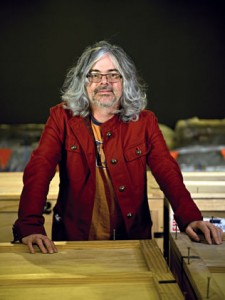Another brilliant piece from a GUNNAS WRITING MASTERCLASS writer.
I lay in bed last night, unable to stop thinking about my recent experience of the phenomenon that is MONA and MoFo. Having torn myself away from such stunning creativity and beauty to return to Melbourne yesterday, I have now been struck down with an awful case of FOMO (fear of missing out).
Over the last several days I have listened to folk music in a barn built in 1801, been serenaded by Ngaiire and the Australian Art Orchestra in the Theatre Royal, discovered the power of organ music in the Town Hall and meditated to some amazing sounds at the Baha’i Centre. I rushed from the hotel to venue to restaurant to venue. I sat in crowded rooms, perhaps filled with people like me, who may be experiencing these sorts of music for the first time, or perhaps musicians in their own right. But we were all enthusiastic; attentive and open to whatever we might be offered up to us from the artists.
I made the most of Faux Mo as well, dancing alongside you and a group of fabulous people in the Laundry until the DJs were regretfully silenced. However, while all parties must come to an end, the same cannot be said of MONA. This brings me to the key reason for this letter. Having visited MONA for the first time on Thursday, I feel compelled to write to tell you a little of my experience and to say thank you. Of course, my small voice is but one in a chorus of many people who sing the praises of this museum.
On my journey out to MONA I was amused to discover that you weren’t joking about “sheep class”, and I giggled at the replica sheep and cow out on the deck and marveled at Trevor, the dusky parrot in his gilt cage. Every detail seemed to be preparing me for what I was about to experience, right down to the soft leather stools that wouldn’t be out of place at Vue De Monde and the warm introduction and commentary from the captain.
Excitement built as the ferry approached the dock, the 99 steps climbing up past the strikingly oxidised building and iridescent lawns. My friend and I run up the stairs, first to the top in our eagerness but now gasping for breath as we wrestle the tickets out of our bag. Then we are drawn down into the subterranean maze, following the gently curling staircase. We enter the first hall, passing the bar with its bounty of jewel-like treasures, and wander through the motley collection of chaise lounges and winged chairs. I skip past one of the first pieces, unwilling to wait for people to move aside. Perhaps this was a mistake but I will have to wait until next time to find out.
I lose my friend quickly, but just as quickly I lose myself as I wander through the first rooms. The Darger collection fascinates and perplexes me. The drawings have a compulsive quality and the contrast of nightmarish shapes of children being abused and murdered followed by drawings sedate, pastel schoolgirls in uniforms and plaits, confounds me. What drives the creation of such a complex, alternate realm? I want to see more and try and understand more of this journey Darger was on. Did his own life lack colour, love? Is he telling these stories for those children that he was never able to adopt?
Similarly, there are many more questions than answers as I stand in awe at Barsamian’s Artifact. The small, flickering openings scattered over the surface of the enormous bronze head have caught my eye from across the room. I’m astounded by the stop motion as apples fall and melt in the palms of many hands and luminescent birds dart through the small spaces. The head lies, on it’s side, seemingly impassive to the crazed, repetitive movements occurring inside the cavernous space. A books opens, pages glittering and turning; iron work spirals continuously; light and patterns reflect through these small windows into the mind. I continue my exploration; now kneeling then on tip toe, in order not to miss a single captivating scene. I am intent on noticing the minutae of the piece yet I’m confounded by the mechanics driving the frenetic movement.
Peering around the corner, I watch as black and white photos are projected onto the wall of a cavernous, black room. The scenes are mesmerising; a man with smiling eyes and mouth holding an outstretched hand, feeding seagulls. The blocks of light and shade bring the people into relief before me; silvery contrast leading me to observe the interactions between the players. The blurred wings of the gulls and the transitions between perspectives have me captivated. With each photo I feel myself being drawn deeper and deeper into the tableau. I have to tear myself away from The Algiers’ Section of a Happy Moment.
This is a recurring theme as I begin to suspect that I could happily spend days exploring, watching and interacting with the pieces. Too soon I must close the box, despite the plaintive ‘I love you’ echoing in the hall, and head downstairs to the waiting ferry. I leave with a full heart and a wildly excited head. I cannot wait to tell people about this perfect place and I am already plotting my return.
To bring an audacious project such as MONA to fruition takes great vision and determination. So, thank you David, for making me feel as though I am part of something bigger, more beautiful and more complex than I could ever have imagined on my own. I loved that I also share this experience with so many other people, who seem equally eager and amazed by this gift you have given, not only to Tasmania, but to every curious visitor who crosses the straits to explore the world of MONA.
Warmest regards, Anna.












